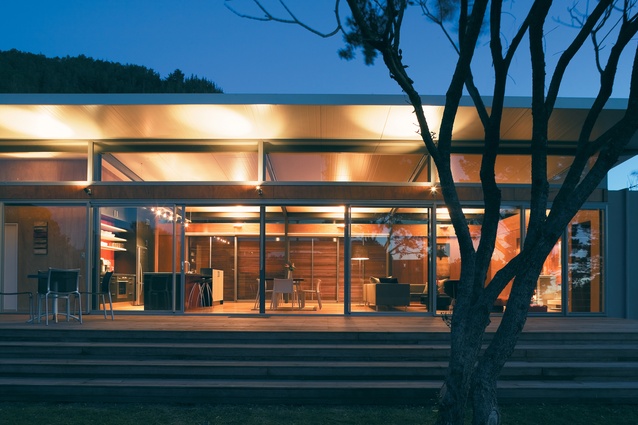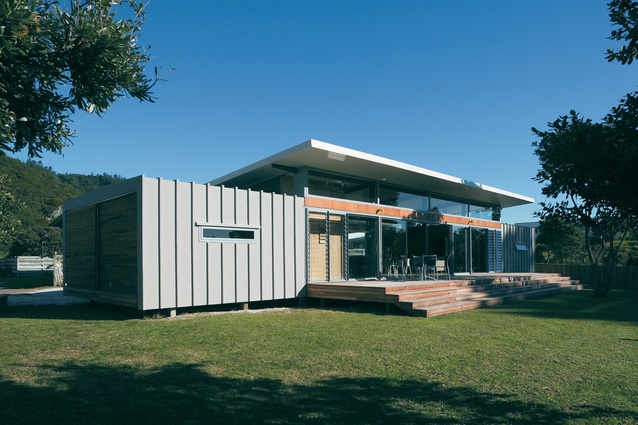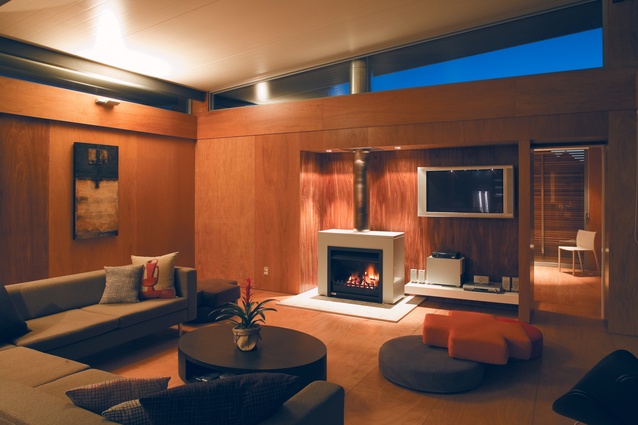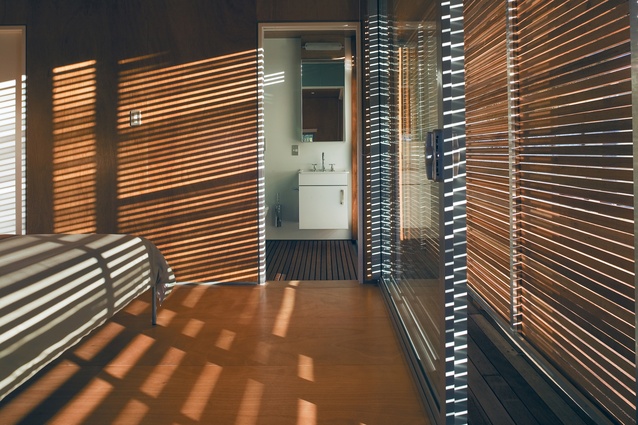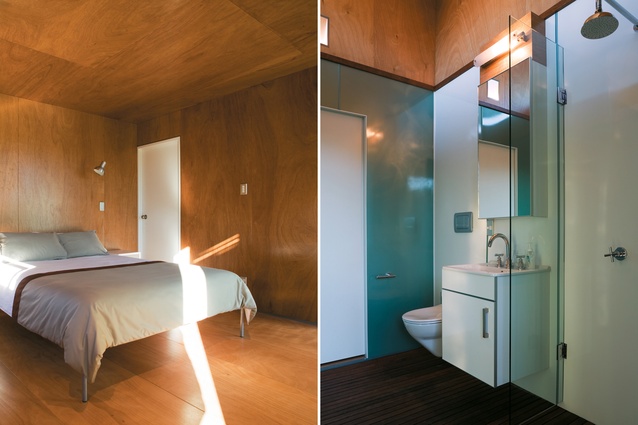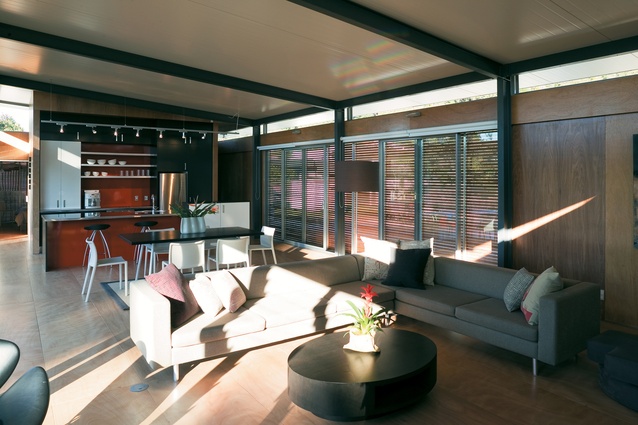Houses Revisited: Little paua
Godward Guthrie’s Coromandel bach from our 2006 archives is an exercise in self-containment and self-conscious nostalgia.
Pauanui (“big paua”) is the name of a small town on the east of the Coromandel peninsula, half way between Whangamata and Whitianga. It has also become a shorthand term – and a pejorative one, at that – for a certain kind of coastal community. Built up, and crowded in summer (when the resident population of 700 grows almost 20-fold), Pauanui connotes suburbia-by-the-sea. Thus, it transgresses what is still considered to be the natural order of the Kiwi bach settlement (and of the Kiwi bach): it didn’t just happen, it was made to happen, by a developer.
There’s a fair bit of snobbery underpinning this judgment, mixed in with some good old-fashioned tut-tuttery. Even for a part of the country that’s never been a locus for the vita contemplativa, Pauanui is unashamedly hedonistic. It’s a good-time place, if your idea of a good time is essentially adolescent, and a nirvana for those who have hit the Kiwi trifecta of bach, boat and Beemer. Unsurprisingly, Pauanui is not a by-word for fine architecture. In the seventies and eighties the prevailing genre was the Lockwood-style house; over the past decade, as the economic tide has risen, Pauanui holiday residences have become more ostentatious, without necessarily becoming much more accomplished.
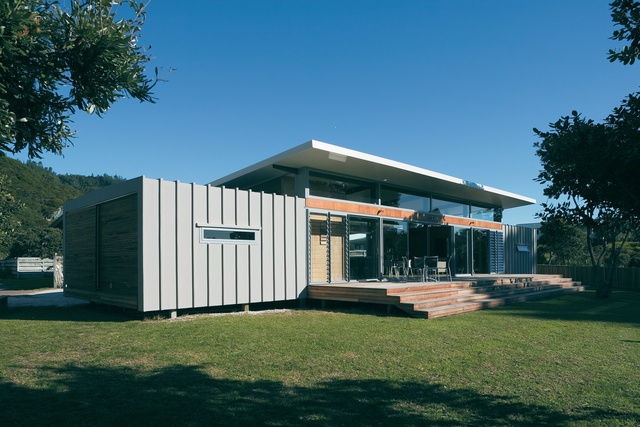
The Latham bach, designed by Julian Guthrie of Auckland practice Godward Guthrie, is an interesting insertion into what is now an established part of the Pauanui development. To a degree, it harks back to that seventies Lockwood heyday, and it’s also rather old school in the way it connects with the pragmatic do-it-yourself bach tradition (although, as we’ll see, this was no ordinary D-I-Y construction job). But the bach also has an affinity with some contemporary baches characterised by a well-designed self-sufficiency.
Of these, the best known – because most published – is the bach designed by Ken Crosson of Crosson Clarke Carnachan Architects for a site at Otama, further north on the Coromandel peninsula. Crosson received an NZIA Supreme Award for the bach in 2004, and non-professional audiences have also found his design compelling: it’s the ne plus ultra of the lock-it-up-and-drive-away box. Its celebrity, undoubtedly, has also been abetted by its ridge-top site and excellent photography by Patrick Reynolds.
The site available to Julian Guthrie doesn’t have the geographical and topographical advantages enjoyed by Ken Crosson. It’s on the flat and it doesn’t have sea views, although it does abut a reserve to the north. Nor is the container effect as pronounced; the bach may be effectively sealed on three sides, not four. But the building is definitely a bach in nature, rather than a house (a stipulation communicated in the client’s brief). As with the Crosson bach, a rather rugged exterior belies a richer interior. The materials – plywood walls and flooring throughout, plywood ceilings in the bedrooms, and a polystyrene ceiling above the main living area – are inexpensive, but competent construction, effective lighting and well-chosen fittings impart a warmth and comfort that usually comes at a far higher price. The bach, perhaps, is not so much paua, as oyster.
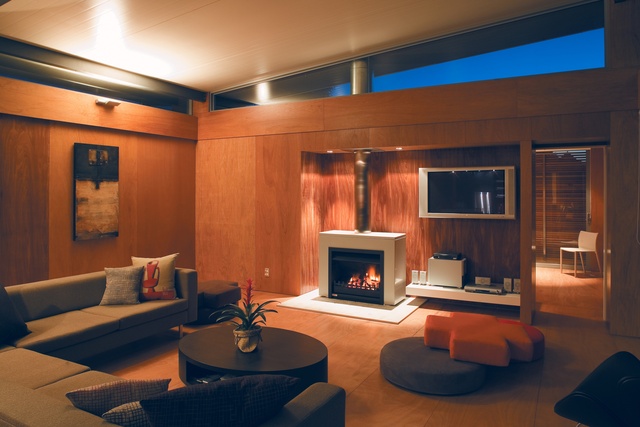
The building’s ‘bachness’ is also a product of its method of construction. It’s not a kit-set – its design was a response to a particular brief and its assembly was the result of a unique set of circumstances – but some of it was pre-fab and all of it was intended to be easy-build. “We used industrial methodologies to build cheaply and quickly”, the architect says. The client owned a construction company – a useful asset if you want your bach ready by Christmas and it’s already October. So, steel portal frames were made in Auckland and trucked to the site, where insulated colorsteel panels were bolted on. By using off-the-shelf cladding and custom-made structural elements, and foreswearing materials requiring finishing trades such as painting and tiling, architect and builder achieved occupation by Boxing Day.
In plan, as Julian Guthrie notes, the bach – 24 metres long by 6 metres wide – is a modern take on the simple, rectangular Lockwood. A low-profiled pavilion flanked by two boxes is jacked up above a flat site on a flood plane from the adjacent stream. (“It looks like you can get a forklift in there and drive it away again,” the architect says.) A central glazed pavilion houses the living area, and at either end two cabins wrapped in aluminium roofing membrane house the bedrooms – plywood cocoons with low flat ceilings and narrow slot windows.
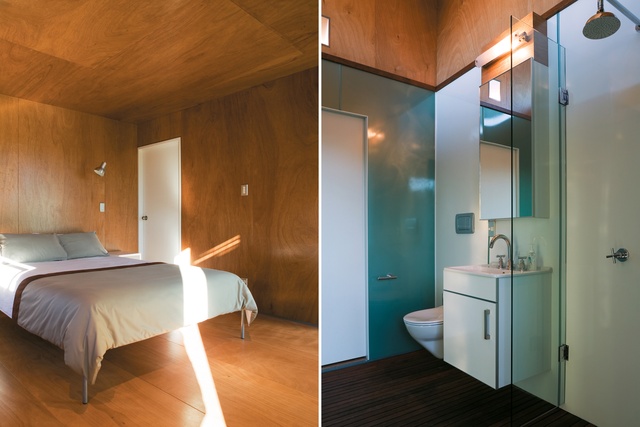
Folding the membrane over the roof and exterior walls obviates the need for guttering: rainwater drops straight down to soak into the sand. Slatted timber screens filter the sunlight, and provide privacy to the open, glazed end of either sleeping ‘cabin’ and to the pavilion on its south side, facing the neighbours. As well as performing this protective service timber slats do humble duty as duckboard flooring in the bathrooms. Floors in other areas are plywood sheet laid over particle board.
Above the pavilion hovers the monolithic roof – a form, the architect says, that is intentionally reminiscent of a surfboard and, again, a solution satisfying structural requirements and budgetary constraints. The roof panels cost $12,000 and were erected in a day. Even more than the flanking ‘cabins’, the slatted screens, and the plywood interior wrap, the roof – white in the day, uplit to cream at night – is the bach’s most singular element. The bach, it seems, wants to take off, not stay put. Given the condition of much Pauanui architecture, that’s an understandable urge. But beyond that, levity is a most desirable quality in a house you go to when you want to get away from it all.
Click here to see more Houses Revisited. And sign up to our email newsletters to receive Houses Revisited straight to your inbox.
Note: These are stories from our archives and, since the time of writing, some details may have changed including names, personnel of specific firms, registration status, etc.

